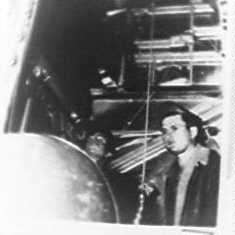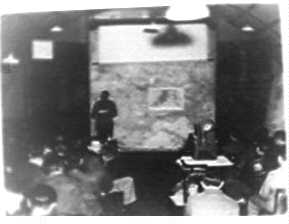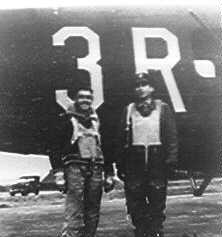THE STORY OF A TYPICAL MISSION
Let's say that you're called at one o'clock in the morning for a two o'clock briefing. After you are awakened by an orderly you dress and either ride a bike (if one is available) or walk down to the mess hall. It's still dark outside except for the moonlight that streams through the overcast. You have to carry flashlights and the beam of light penetrates the mist and morning fog as you find your way among the huts and out to the road. The mess hall is crowded and everyone seems to be talking at once. There is a lot on your mind and you're really not hungry, but you know you will be missing a meal today -- so you eat. After breakfast you either hop into one of the waiting trucks or pedal down to the briefing room. In the distance you can hear the engines being pre-flighted by the ground crews. They sound a long way off to you as you squeeze your way into a waiting truck. There's not too much talking going on now. The briefing room is also crowded and you look around for your own crew members. Then, you try to find a seat as close to the front as possible so as not to miss anything. A large map of Europe hanging on the wall is covered and everyone is speculating as to the target for today. A hush comes over the room as the Group Operations Officer begins to call the roll. All eyes are now glued to the map as the white curtain is raised to reveal the target underneath. You instinctively hold your breath. Today's target is a large industrial plant in Germany and you follow the ball of yarn, as it stretches from England to the target and back again. The briefing is now in full swing and everyone is quiet again, ready to take notes. The knowledge of the target brought on a little commotion but your attention is now on the briefing officer as he points out the flak areas and other danger spots. "Keep right on course at this point, as previous crews reported a flak battery here," he continues, "An escort of P-51's will pick you up here and follow you in and out again." "Watch out for enemy fighters along this leg," etc.
The bombardiers and navigators are then dismissed in order to attend their own special briefings. The navigators have to chart the course to be followed on their different maps and the bombardiers will get more detailed information about the target area, etc. The heading in to the target is studied closely in order to memorize the check points on the way. The data for the bombsight is also given to them but they'll have to re-check it after they are air-borne. In the meantime, the co-pilots are checking out the "escape kits" we will carry today. They will include small maps of the target area and local currency to be used if needed. We also carried small photos of ourselves taken in a civilian jacket, to be used by the "under-ground" in forging identification papers for us in the event we had to evade capture. The radio operators checked out the call letters and radio frequencies for today's mission in case we run into trouble. And the gunners went to the armament shack to check out their .50 cal. machine guns. As each was through -- he proceeded to the equipment room to change into flying clothes. The electrically - heated suits we are issued are a God-send. Up at 25 to 30,000 feet it gets mighty cold --- sometimes around 50 degrees below zero. Our Mae Wests and parachute harnesses are donned amid a lot of kidding around. A voice across the room asks, "Say Joe, how many does this one make?" A loud "Ten" is heard and someone else's voice will counter with, "Number twelve for me." You're finally all dressed -- pick up your helmet and oxygen mask, as well as your equipment bag and proceed out to one of the waiting trucks to take you to your hard-stand where your plane is waiting. The ride there is quiet as you think about the next few hours. You disembark at your hard-stand, gather your stuff and wave to the crew members still on board, as the truck pulls away and heads to another nearby plane.
Before you realize it you have to get on board and get ready for take-off. The sun is in sight now, a huge red ball on the horizon. There is a thin haze over the field and you look around to see all the other planes in the area getting ready, too. The pilots are going over their check lists and watching for the flare to be fired from the tower. The signal is given to the crew-chief and he gets his fire extinguisher ready. The engines are started and you proceed to taxi into position and await your turn to take off. The ship is heavy with it's load of bombs and fuel and as you race down the runway on the take-off you can almost feel it straining to get into the air. The end of the runway is below you as you begin your climb, and the wheels come up slowly as the ship wavers a bit from the prop-wash, before settling down. Everyone goes to their station --- plugs in their inter phone and heated suits --- and waits for what lies ahead. The planes first form into "Flights" at the prescribed altitude and then into "Squadrons" and "Group" formation. The Group assembles in "Wing" formation and at the "briefed" time and place it falls into position with the "Division." You are now a part of the long bomber stream heading for Europe. You've been flying for over two hours and you're still over England. During this period -- and before you have to put on your oxygen mask -- the bombardiers make their way back to the bomb bays and remove the "pins" from the bombs. Now the bombs are "armed" and will explode on impact. This is a tricky operation as we cannot wear a parachute in the close quarters of the bomb bay. You then make your way back to the nose and hook- up your inter phone and electric suit again. The briefed route is followed and you find yourself over the Channel and on your way. The exacting job of getting you here "on course" and "on time," is the responsibility of the "lead navigator." It's quite a job, believe me. By this time you have put on your oxygen mask and have given the Gunners the order to test-fire their guns into the channel below or into the open sky around us. The plane rattles and shakes as the guns are fired and you can smell the gunpowder through your oxygen mask. You get your heavy and cumbersome flak suits ready to put on. The Channel below looks like a huge mirror -- so calm and quiet. An occasional cloud is seen and our contrails, formed by all the planes, also begins to fill the air around us. The dim, dark outline of France can just barely be seen in the distance. As you get closer to the enemy-held coast your stomach muscles tighten up and you unconsciously hold your breath. You relax a little as you hear the navigator's voice over the intercom say, "On course." A few bursts of flak are off to the side but you are not hit, thanks to the good job of navigation. Everyone is tense now as you wait for what lies ahead. After you cross the Channel some Groups break from the bomber stream and head for their own targets --- some in France and others in Germany. Depending on the war strategy at the time -- our targets may be classified as "Strategic" (industrial plants, oil refineries, sub pens, etc.) or "Tactical" (railroad marshaling yards, airfields, etc. ). The 9th Air Force, flying medium bombers ( the B-26, A-20), as well as their fighters, were transferred to France after D-Day and were primarily used as a tactical air force -- while the 8th. remained in England, and once the "landings" were established, we returned to our original responsibility of concentrating on the German industrial complex. (cont'd on next page) |
 The ball really starts rolling the
night before the mission. The Squadrons are alerted and S-2 begins working on the target information, such as route, bombing altitude, bomb load,
flak batteries in the area, weather expected, and other details necessary for the next morning's briefing. The crews selected to fly the mission
are usually awakened an hour or so before the briefing time, but the "lead crews" are alerted the night before in order to attend a
pre-briefing. They get much more detailed information about the mission because the success of the whole thing rests on their shoulders. It is quite
a responsibility.
The ball really starts rolling the
night before the mission. The Squadrons are alerted and S-2 begins working on the target information, such as route, bombing altitude, bomb load,
flak batteries in the area, weather expected, and other details necessary for the next morning's briefing. The crews selected to fly the mission
are usually awakened an hour or so before the briefing time, but the "lead crews" are alerted the night before in order to attend a
pre-briefing. They get much more detailed information about the mission because the success of the whole thing rests on their shoulders. It is quite
a responsibility. Pilots are making notes as to their
position in the formation; the altitude to form at; as well as the approximate E.T.A.'s involved. Pictures of the target are flashed on a screen
and everyone makes a mental note of them. The weather man makes his carefully prepared speech, "Clouds shouldn't bother you at all today and
visibility at the target will be good. At your return to the base you will find clouds high enough to enable you to come in beneath it." They sure
had a hard time trying to predict the weather over England and we often questioned their information. But we gave them an "E" for effort.
Pilots are making notes as to their
position in the formation; the altitude to form at; as well as the approximate E.T.A.'s involved. Pictures of the target are flashed on a screen
and everyone makes a mental note of them. The weather man makes his carefully prepared speech, "Clouds shouldn't bother you at all today and
visibility at the target will be good. At your return to the base you will find clouds high enough to enable you to come in beneath it." They sure
had a hard time trying to predict the weather over England and we often questioned their information. But we gave them an "E" for effort. The gunners have already loaded their
guns in the turrets and you can see the figure of the engineer silhouetted against the coming dawn, as he crawls around the ship checking it over.
"Station time" is about half an hour away -- so after you've stored your equipment and checked your own position, you gather outside with the
rest of the crew. The bombardier has checked the bomb load and bombsight -- the navigator has spread out his maps on the folded-down table in the
nose -- and the pilots have completed their walk around the plane with the crew- chief, looking it all over. Some men grab a last smoke. (but not in
our crew -- Fred was very strict about anyone smoking around our plane). There's some joking going on and it's hard to believe that in a few
short hours your very lives will be at stake.
The gunners have already loaded their
guns in the turrets and you can see the figure of the engineer silhouetted against the coming dawn, as he crawls around the ship checking it over.
"Station time" is about half an hour away -- so after you've stored your equipment and checked your own position, you gather outside with the
rest of the crew. The bombardier has checked the bomb load and bombsight -- the navigator has spread out his maps on the folded-down table in the
nose -- and the pilots have completed their walk around the plane with the crew- chief, looking it all over. Some men grab a last smoke. (but not in
our crew -- Fred was very strict about anyone smoking around our plane). There's some joking going on and it's hard to believe that in a few
short hours your very lives will be at stake.